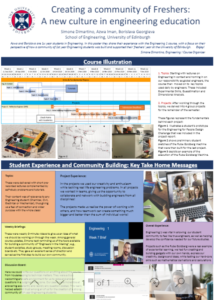This description was prepared by two 1st year Engineering students, Azwa Iman and Borislava Georgieva. They share their experience of how the Engineering 1 course fostered a strong community of students. Engineering 1 is a course for all 1st year engineering students.
We worked with students from all engineering disciplines, so we could feel much closer to all of our peers. We played our role as “engineers in the making” since day 1 through 4 different group projects. We were allowed to set our own objectives based on our interests and strengths, creating a safe environment where the whole team could explore their own capabilities as well as testing our limits while interacting with our peers. The assessed elements helped us nurture our self-awareness as individuals and recognise the potential inherent to teams.
The course was built around keystone lectures relevant to all Engineering disciplines. These helped create a handful of skillsets that we were able to utilise not only in our projects this semester, but throughout our engineering careers. The topics supported the projects, which is a major element of innovation here. The project-based learning approach was used to make this course consistent with 100% coursework assessment. Each project was done in teams, which really helped with expanding our network and built strong student communication and relationships.
In the Rube Goldberg Project we designed, built and executed a Rube Goldberg device, which is a device that achieves a simple task such as pouring a cup of coffee in an overcomplicated manner. Each of us oversaw a module of the whole device. This project was extremely worthwhile and challenged our teams to work together in an online platform to build and execute a machine that worked in harmony without ever being in the same room together! In another project, the Engineering for People Design Challenge, we explored the culture, politics, history and geography of two small Peruvian villages facing a range of engineering challenges. Our goal was to design and propose a sustainable solution to improve the quality of life of the locals. Other than working with others engineering students, it is inspiring to think that our work can have a far-reaching impact on other communities!
Alongside the projects and tutorials, there were also discussion boards available for us to ask burning questions to our peers, further strengthening our student community. They were a safe, useful tool for communication and interaction in this new virtual learning environment, making them an invaluable tool. They were extremely helpful in increasing the level of collaboration as they allowed us to come together and brainstorm solutions to every question we had. Although we found this course challenging, it drove our ambitions to work harder. As a result, we produced work of extremely high quality. As well as this, due to the team aspects of each project, we were all able to truly learn the importance of teamwork and develop not only hard-core skills but also important, soft core skills such as project planning, communication and writing, but also becoming independent learners embedded into a wider virtual community. All in all, the lectures, tutorials and projects, paired with the weekly briefings and discussion board, were an inspiring method in creating a well-functioning wider virtual community of engineers of all interests and abilities.

